How we created our own terminal network
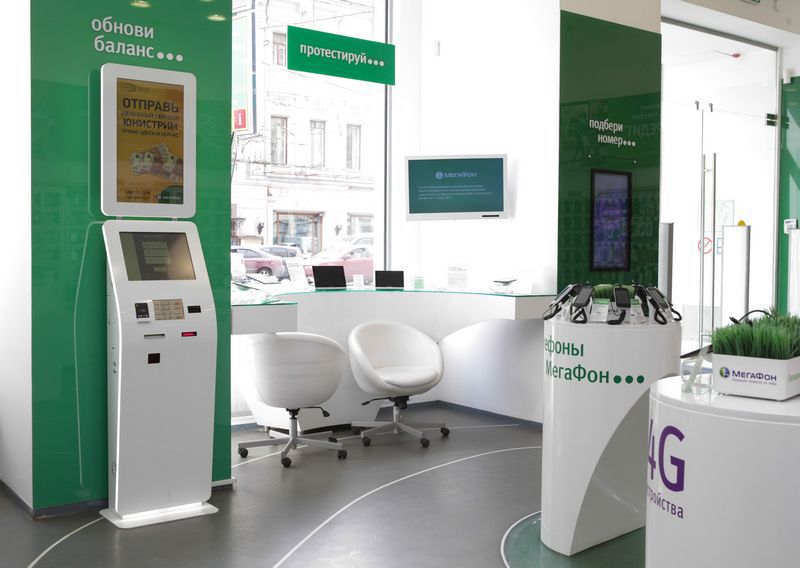
Hi, Habr. In August 2013, we began to create our own network of payment terminals. 10 months have passed since then, the terminal park has grown significantly. And today we would like to tell you more about the design features of the terminal, its potential to expand the capabilities of the device and our future plans for the development of the terminal network.
Objective of the project
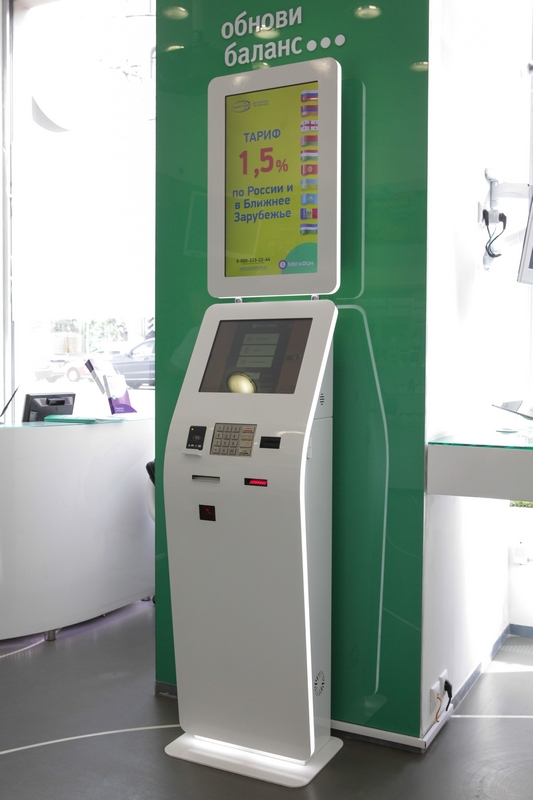
Payment terminals are a very convenient tool: through one device, you can quickly pay for all kinds of services, from cellular communication to water and electricity bills. Without access to a computer and the Internet, there is no need to register on the websites of different service provider companies. This is a recognized payment method by millions of users. Earlier, terminals were provided by partner companies, but the experience of customers using terminals in our stores reflected on us. When the terminal is installed in the “MegaFon” salon, then all questions regarding its work and wishes to add new services are addressed to the salon employees.
')
Therefore, we decided to create our own network of terminals for use in MegaFon salons. The goal of this project was to provide a high level of service and prompt response to all customer requests. And this could be achieved only by controlling all the components of the terminal network, starting from the devices themselves and ending with the processing center. For example, unlike many other networks, in 90% of cases we check in advance the possibility of making a payment, which allows us to reduce the time it takes to complete a transaction.
Terminal design
First of all, it was decided not to use the terminals of standard designs, but to create our own device, which has a large set of possibilities for receiving payments and with the possibility of further expansion. We decided not to limit ourselves to accepting cash, but to create a terminal that, in addition to being able to accept bills, will be equipped with modules for working with bar codes, bank cards and NFC. The latter feature in the future will allow our users to recharge tickets for public transport, as well as to use for payment mobile devices equipped with an NFC-module.

For example, we have already reached an agreement with the Moscow Metro on the integration of MegaFon terminals with the Troika system. And by the end of the summer, we plan to provide the opportunity to replenish the balance of this universal transport card using our terminals. Today, a number of technical and legal issues are being worked out.
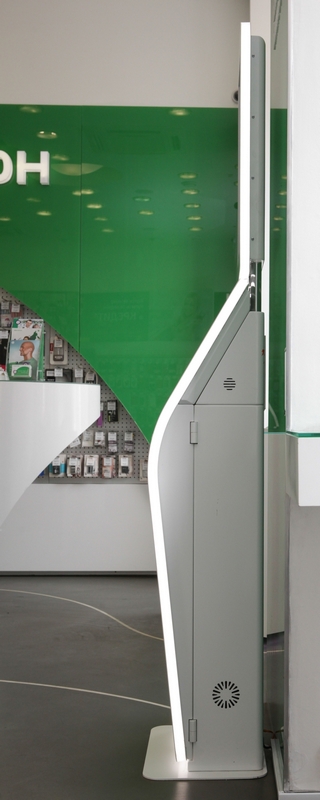
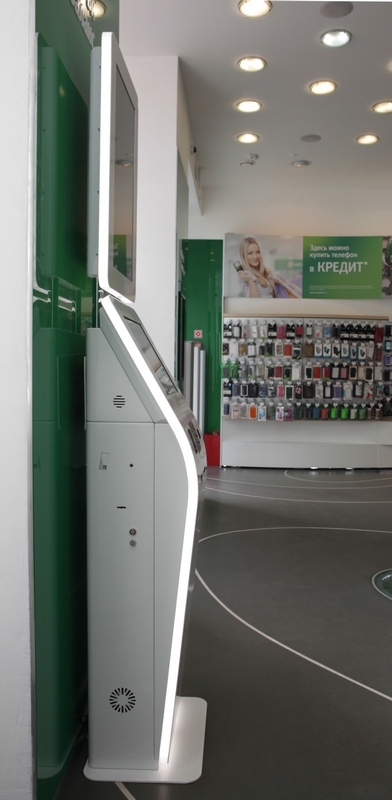
From a hardware point of view, the terminals are fully prepared to receive all three types of payments: cash, using credit cards and in a contactless way. The timing of the introduction of the latter two types of operation depends exclusively on the coordination of financial and legal conditions with all interested parties. After that, payment using credit cards and contactless way will be possible after one of the software updates.
We have already mentioned that barcode scanners are embedded in our terminals. At the moment, the software allows you to read bar codes, in the future we will introduce support for various two-dimensional codes (for example, QR). Barcode scanner allows you to quickly enter all the details of the payment making it easier to pay utility bills or traffic police fines

Appearance has also changed. We have gone from standard angular pillars. The lower touch screen has a diagonal of 17 inches. In addition, we supplied the terminal with a second display with a diagonal of 27 inches and a resolution of 1920x1080, which serves as an advertising medium. This allows you to very effectively attract the attention of visitors to the salons, especially when displaying a bright and dynamic picture on the upper display. Even if the person did not go to the terminal, then with high probability he would notice the image on a large display from a distance.
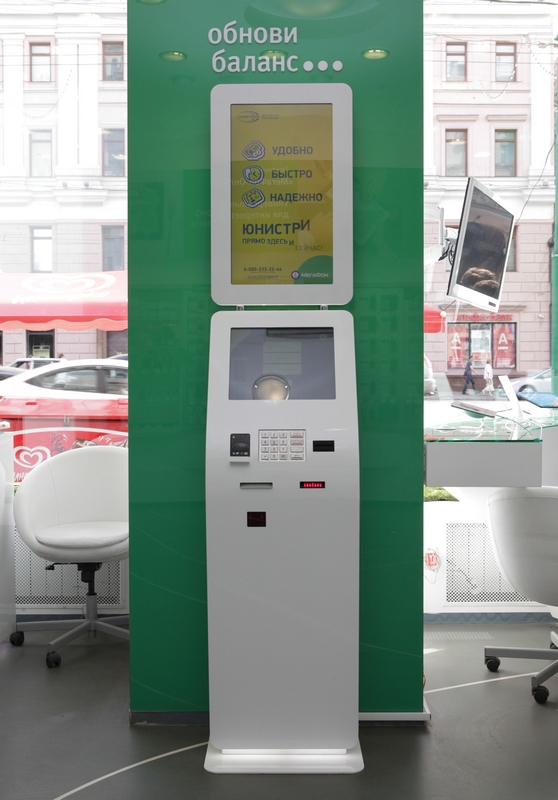
To avoid "brakes" during the demonstration of high-quality graphic information, we have assembled a fairly productive system:
• Processor: Intel Original LGA-1155 Pentium G2130 (3 GHz)
• Motherboard: Asus P8B75-M Soc-1155 iB75 DDR3 mATX AC`97 8ch GbLAN SATA3 VGA + DVI + HDMI
• RAM: DDR3 2048Mb 1333MHz Crucial (ST25664BA1339)
• Video card: Palit PCI-E NV GF210 512Mb 32bit (TC) DDR3 625/589
All terminals are made in Russia, which allows much better control of the build quality. In particular, our employees leave for the acceptance of each new batch to monitor compliance with all requirements. The nonstandard configuration of the terminal case has led to the fact that the production process has become more complicated compared to the "normal" terminals, but thanks to this we have provided convenient service. In addition, the project has strict requirements for the wear resistance of the nodes. This led to the fact that the first batch of terminals returned to production until the required quality indicators were obtained.
Software
MegaFon terminals are running Windows Embedded Standard 7. This avoided a number of problems related to information security, which is typical of terminals running Windows XP.
A lot of attention was paid to the development of the user interface. We did not reinvent the wheel and analyzed the experience of other companies. After all, it is better to learn from the mistakes of others. We have tried to avoid miscalculations in the interface, characteristic of third-party terminal networks. In particular, advertising overload, especially in the form of pop-up windows, on which you can hardly find the "close" button. Our interface is divided into strictly fixed zones for displaying advertisements, controls, and displaying useful information. And these zones never intersect, do not change their size. We do not allow buttons with different actions, for example, “next” and “undo”, to be displayed in the same place of the display in different cases. Before coming to the current interface, we conducted a study of the convenience of different options for the placement of controls. In particular, the optimal time was selected between the automatic change of information on the screen, so that users had time to enter all the data, but also that the input form was not displayed for too long. For each form, we empirically arrived at different time intervals, from 30 to 120 seconds.
Such measures allowed to significantly reduce the proportion of errors when working with terminals. Users have gained experience using terminals, buttons are pressed intuitively, in the way that is familiar to the user. For this reason, we have kept the navigation layout familiar to users of terminals.




Network infrastructure
To install the terminal in the cabin does not require any special preparations. Enough electrical outlet and network cable. Data exchange takes place through the MegaFon internal network, which allows for a high level of security. We also do not use third-party data centers to operate the terminal network, all transaction processing is carried out at our own facilities. Communication security is provided by a tunnel to each terminal.
Economic advantage
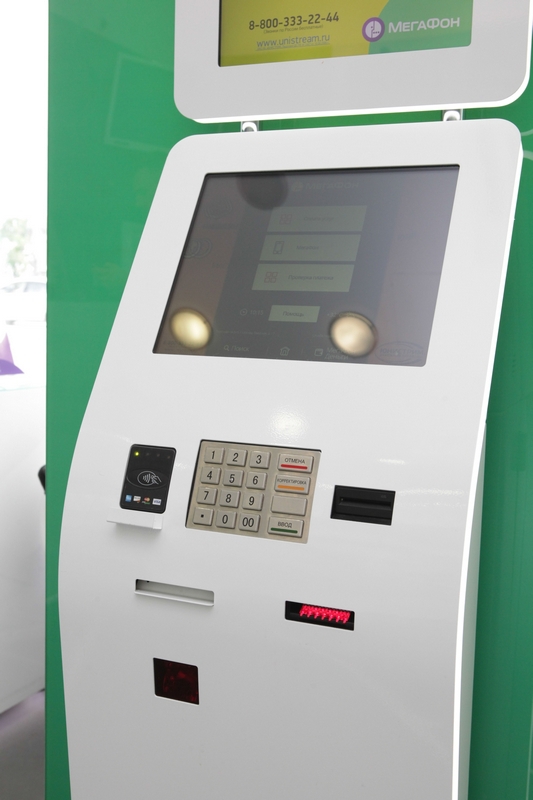
Perhaps the greatest negatives among users of the terminals are commission charges. In some cases, they reach a completely indecent size. For example, at airports it is up to 20% of the payment amount. In the MegaFon network of terminals we do not charge for payments. Rare exceptions are cases when the service provider himself sets a condition for accepting commission. In most cases, the cost of services is paid in our terminal network at par. The recoupment of the project is due to the sale of advertising and receipt of agency fees. Therefore, users in our stores can, for example, pay a subscription fee for using the Internet and online games, transfer electronic money, pay for the services of any mobile operator without additional overpayments.
Conclusion

Now our fleet of terminals is about 700 pcs. By the end of the year, we plan to reach the 2000 mark. So far, the usage statistics have not brought any discoveries: 90% of transactions are payments for cellular communications, which is completely expected. The peak of payments falls on the junction of the months: 2-3 days of the previous and first days of the next. Usually during this period the daily turnover in the terminal network grows 2.5-3 times. This is a completely understandable phenomenon: people receive salaries and rush to spend honestly earned money.

There are no differences in the preferences of users from megalopolises and surrounding areas, most often the same services are paid for, of course, taking into account the region. Other data can be cited after the start of accepting bank cards and contactless payments.
In the near future: the introduction of services such as payment of air and railway tickets, movie tickets, payment of parking lots and all kinds of traffic police services including fines and other payments.
Source: https://habr.com/ru/post/231235/
All Articles